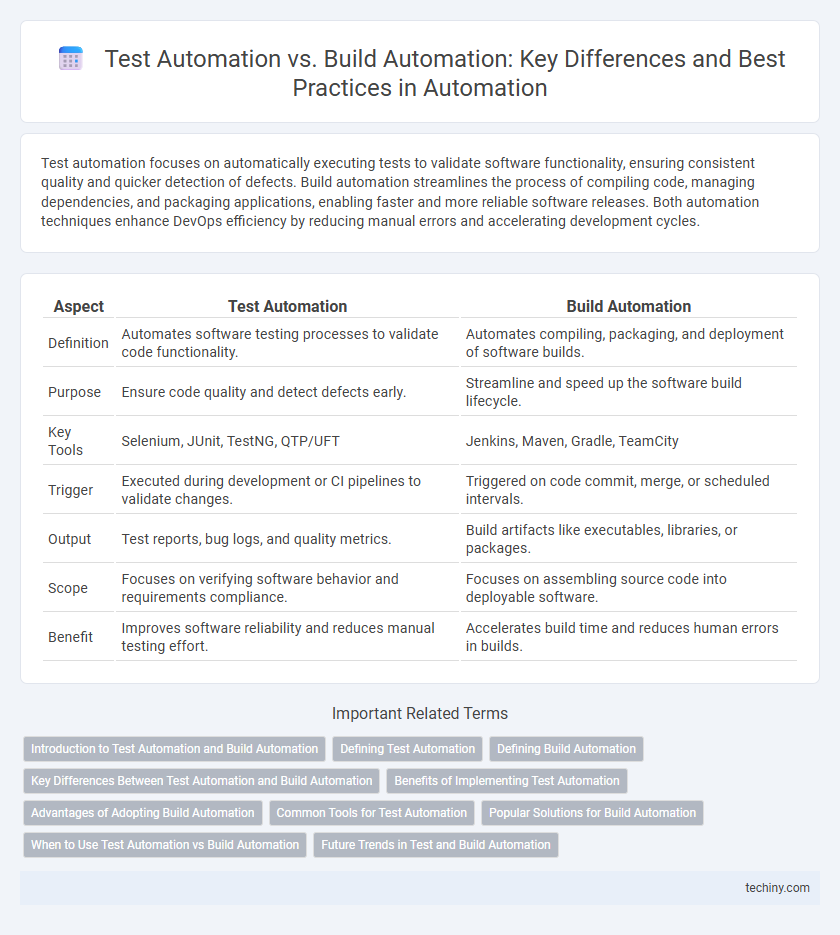Test automation focuses on automatically executing tests to validate software functionality, ensuring consistent quality and quicker detection of defects. Build automation streamlines the process of compiling code, managing dependencies, and packaging applications, enabling faster and more reliable software releases. Both automation techniques enhance DevOps efficiency by reducing manual errors and accelerating development cycles.
Table of Comparison
| Aspect | Test Automation | Build Automation |
|---|---|---|
| Definition | Automates software testing processes to validate code functionality. | Automates compiling, packaging, and deployment of software builds. |
| Purpose | Ensure code quality and detect defects early. | Streamline and speed up the software build lifecycle. |
| Key Tools | Selenium, JUnit, TestNG, QTP/UFT | Jenkins, Maven, Gradle, TeamCity |
| Trigger | Executed during development or CI pipelines to validate changes. | Triggered on code commit, merge, or scheduled intervals. |
| Output | Test reports, bug logs, and quality metrics. | Build artifacts like executables, libraries, or packages. |
| Scope | Focuses on verifying software behavior and requirements compliance. | Focuses on assembling source code into deployable software. |
| Benefit | Improves software reliability and reduces manual testing effort. | Accelerates build time and reduces human errors in builds. |
Introduction to Test Automation and Build Automation
Test automation involves using software tools to execute pre-scripted tests on applications, ensuring functional correctness and accelerating quality assurance processes. Build automation focuses on automating the compilation, packaging, and deployment of code, streamlining continuous integration and delivery workflows. Both test automation and build automation play critical roles in DevOps pipelines by enhancing efficiency, reliability, and speed in software development cycles.
Defining Test Automation
Test Automation involves using specialized software tools to execute predefined test cases, validate application functionality, and identify defects without manual intervention. It ensures consistent and repeatable testing processes, accelerating the detection of bugs during the software development lifecycle. Unlike Build Automation, which automates code compilation and deployment, Test Automation focuses specifically on verifying software quality and performance through automated test execution.
Defining Build Automation
Build Automation refers to the process of automatically compiling source code into binary executables, managing dependencies, and packaging software for deployment. It streamlines repetitive tasks such as code compilation, linking, and running unit tests, enhancing development efficiency and consistency. Tools like Maven, Gradle, and Jenkins facilitate build automation workflows, reducing manual errors and accelerating software delivery cycles.
Key Differences Between Test Automation and Build Automation
Test Automation focuses on validating software functionality by executing predefined test cases to detect defects, while Build Automation emphasizes compiling source code and creating executable applications efficiently. Test Automation tools typically include Selenium, JUnit, and TestComplete, whereas Build Automation relies on tools like Jenkins, Maven, and Gradle for automating code integration and deployment. The primary difference lies in their purpose: Test Automation ensures software quality through systematic testing, whereas Build Automation streamlines the development lifecycle by automating code compilation and delivery processes.
Benefits of Implementing Test Automation
Test automation enhances software quality by enabling rapid, consistent, and repeatable execution of test cases, reducing human error and accelerating release cycles. It provides comprehensive test coverage and early detection of defects, which minimizes costly post-release bugs and improves overall product reliability. Implementing test automation streamlines continuous integration and delivery pipelines, fostering higher development productivity and faster time-to-market.
Advantages of Adopting Build Automation
Build automation accelerates software development by streamlining repetitive tasks such as compiling code, running tests, and packaging applications, leading to consistent and error-free builds. The integration of tools like Jenkins, Maven, and Gradle reduces manual intervention, enabling faster delivery cycles and improved team collaboration. Implementing build automation enhances code quality, minimizes integration issues, and supports continuous integration and continuous deployment (CI/CD) pipelines, ultimately boosting overall development efficiency.
Common Tools for Test Automation
Common tools for test automation include Selenium, JUnit, TestNG, and Appium, which enable automated testing of web and mobile applications to improve efficiency and accuracy. These tools support various testing types such as functional, regression, and integration testing, facilitating continuous integration and delivery pipelines. By integrating with build automation systems like Jenkins or Bamboo, test automation tools ensure consistent quality checks throughout the software development lifecycle.
Popular Solutions for Build Automation
Popular solutions for build automation include tools like Jenkins, Apache Maven, and Gradle, which streamline the process of compiling, testing, and packaging code. These platforms support continuous integration and deployment pipelines, enhancing development efficiency and consistency. Cloud-based options such as GitHub Actions and Azure DevOps also offer scalable, flexible build automation tailored for modern DevOps workflows.
When to Use Test Automation vs Build Automation
Test automation is ideal for validating software functionality, executing repetitive test cases, and ensuring code quality throughout the development lifecycle. Build automation is best used for compiling source code, packaging applications, and automating deployment pipelines to streamline software release processes. Choose test automation when the focus is on continuous testing and quality assurance, while build automation is essential for efficient and error-free software integration and delivery.
Future Trends in Test and Build Automation
Future trends in test automation emphasize AI-driven intelligent test generation, enabling adaptive and predictive testing that reduces human intervention. Build automation advances focus on cloud-native pipelines and containerization, enhancing scalability and continuous integration/continuous deployment (CI/CD) efficiency. Integration of machine learning with both test and build automation fosters real-time analytics and proactive defect detection, setting new standards for software delivery speed and quality.
Test Automation vs Build Automation Infographic

 techiny.com
techiny.com